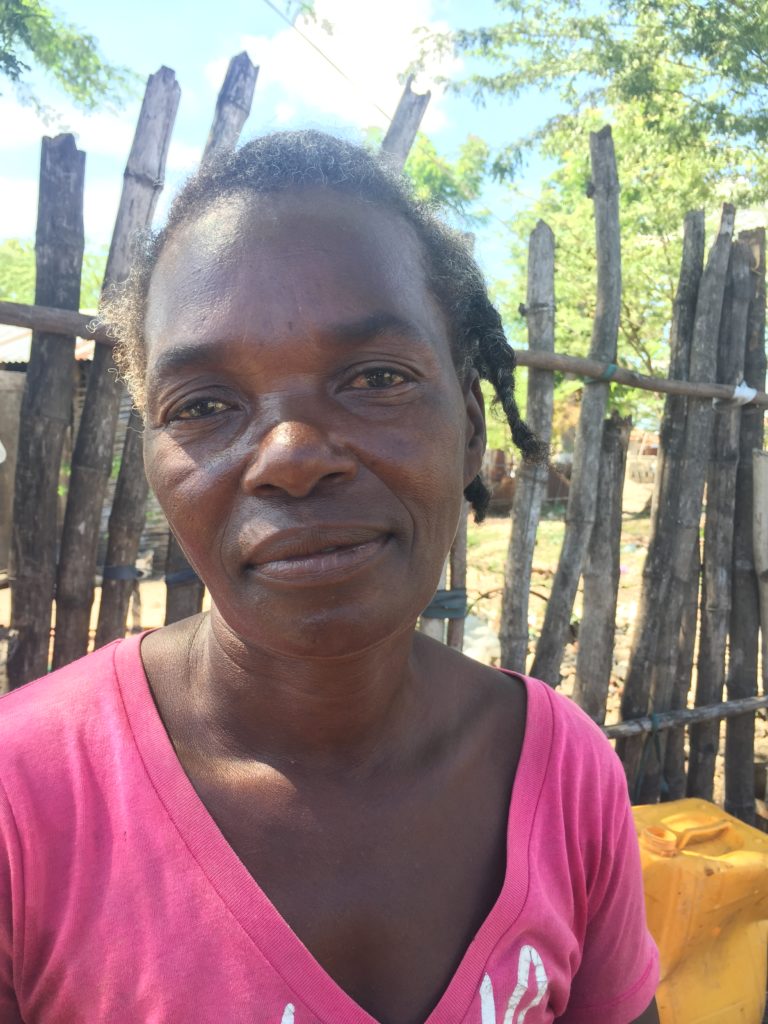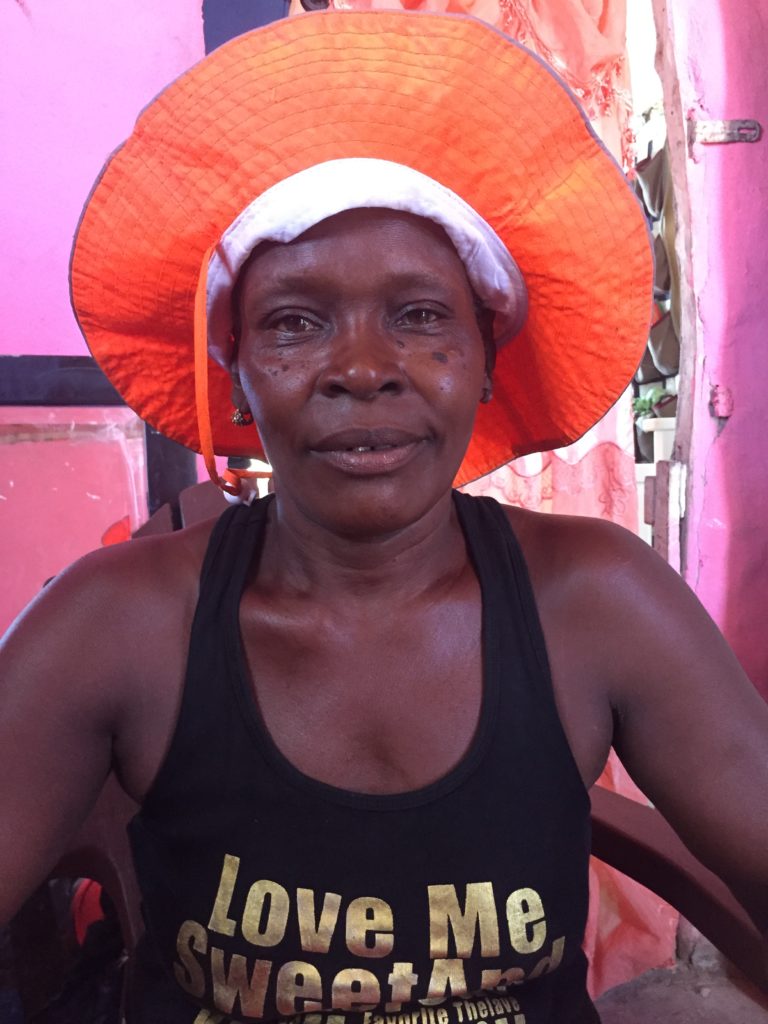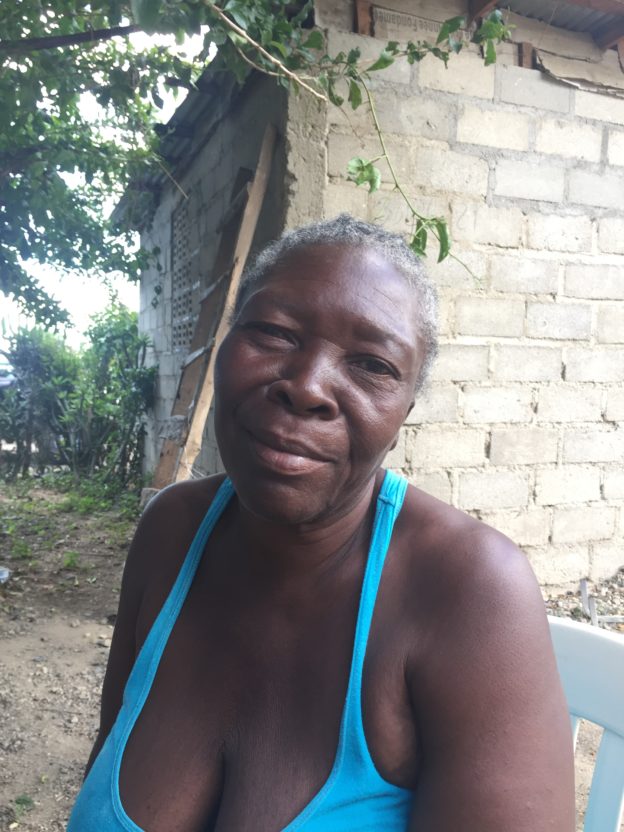Fonkoze piloted the CLM in three regions: Lower Lagonav, Boukankare, and Twoudinò. At the time, they were rated as the three poorest parts of the country. In each area, the team worked with fifty families.
Twoudinò is in Haiti’s northeast, a region that has seen important changes since the CLM graduation. The main road between Okap, Haiti’s most important northern city, and Wanament, on the Dominican border, is now smoothly paved. Its completion has facilitated trading in the region because both Okap and Dajabon, the Dominican city across from Wanament, are important market towns. In Karakòl, just north of Twoudinò, post-earthquake relief funds helped establish a park of assembly factories that now employs almost 15,000 people. Excess electricity generated at the park makes the region the only one in Haiti with reliable power all the time.
Elissiène lives in Kayès, not far from the park. Her home is a multi-room cement house in the back of her yard. Her two youngest children still live with her, and the three older ones are off on their own. She’s a widow and has been one since before she joined CLM. Cement homes belonging to two of her grown children – “off on their own” doesn’t mean distant – sit in front of and on either side of her house, the three together forming a semi-circle.
She started the program with goats and poultry as her activities, and she managed both well. Eventually she was able to sell off her other livestock to buy a cow. But she didn’t feel as though she could take care an animal that big by herself, so she turned it over to a neighbor. He would receive every other calf it produced as his payment for caring for it. Neither he nor Elissiène benefitted from the arrangement, however, because the cow was stolen.
While she was part of the program, she also developed a small commerce. She used savings from her weekly stipend to get started. Eventually, she was selling bread, sugar, local rum, cigarettes, and other high turn-over items. The commerce prospered and she maintained it for years. “If you are a woman and you’re in business, as long as you know what you’re doing you’ll make some money.”
But she sold out her business a couple of years ago and threw all the capital into improving her house. She felt as though she had no choice. Two of her children got jobs in local factories, and they needed their mother as a full-time babysitter. Now that the kids are getting a little older, she’d like to go back into business. “I can leave them for short periods, now.” All she would really need to do is go off to buy her merchandise. She would sell, as she always did, right out of her home. Going back to earning an income, even a small one, is important to her. Her youngest child missed out on the national 9th-grade graduation exam last year because Elissiène owed money to her school.

If you go to Jakzil and ask for Anne Marie’s home, they’ll try to take you to one of the three nearby women named Marie. But you won’t find Anne Marie. She’s married to a man they call “Kòk,” and no one knows her by anything except “Mad’ Kòk”, or Mrs. Kòk. “If you ask for Mad Kòk, anyone around her will bring you straight to my home.”
Jakzil is a village of closely-spaced shacks on the plain near Haiti’s northern coast. The Atlantic Ocean is just a few steps away. Anne Marie, like Elissiène, received goats and chickens when she first joined the CLM program, and she managed them with great success. By the time she graduated, she was ready to buy her second cow. In the years that followed, she sold the four calves they produced and invested the money in the house she lives in now. It has all been her work, because though she is known exclusively by her husband’s name, she cannot count on him to contribute to the household.
Jakzil was arid to start with, and in recent years drought has very much reduced her access to grazing for her cows. She watched the two big ones losing weight and getting sick. She eventually sold them at a loss to a local butcher.
But she did so with a plan. While in CLM program, she had built a small commerce selling salt. As a retailor, she saw the potential benefits of a larger business. So, she took the money from the sale of her cows and bought a salt basin. The coast around Jakzil is one of the areas that produces the coarse salt that is principally consumed in Haiti. Anne Marie lets sea water into her basin and then closes it off, letting the water evaporate. Once a month or so, she can harvest. A single harvest can bring in 10,000-15,000 gourds. She doesn’t have time to manage the basin herself, though. A neighbor does it for her, and they split the income.
She doesn’t, however, depend entirely on that income. She spends much of her time hunting tchatcha, a kind of small, saltwater crab used in Haitian cooking, and other small crustaceans she can find along the shore. She sells these to merchants, who bring them to market. She also gets a regular monthly salary from a local school with a school lunch program. She supplies them with the firewood they need in their kitchen. She collects it locally.
She’s focused now on her youngest child, a teenage daughter who still lives with her. Her most important goal is to keep sending the girl to school. “She’s my youngest. She’s the one I have to raise the highest.”

Rosette also lives in Jakzil. She had nine children, and eight of them survive. Her four youngest are still in school. Two will be in their last year of high school this year, and two will be in 10thgrade. She has had to raise them alone.
She too chose goats and poultry as her two CLM-activities. They flourished while she was part of the program, but didn’t last long afterwards. “There was so much draught. The livestock couldn’t survive.”
So, Rosette found another way to get by. Her neighborhood is part of the area served by the electricity generated at the Karakòl factory park. Her home has electricity all the time. She acquired a freezer. She buys five-gallon jugs of treated drinking water and fills small plastic bottles. She freezes them and sells them as ice. A jug of water costs 25 gourds, and she can sell the ice for more than twice as much.
She remembers the program fondly. She especially enjoyed the group trainings. “You have to learn to be comfortable around people. You have to change, and we changed.”

Hi Steve, These stories are very interesting, and I’m so happy that you are doing them. However, I think it would be useful to do a bit more analysis or deepen the interview. For instance, would these women qualify for CLM today? Do they have any/qualify for financial services? What do they think are the most lasting results from the program for them personally? Thanks!